Welcome to Xiangning's Homepage

3665 Discovery Drive
Boulder, CO 80303
I am a research associate at the Laboratory for Atmospheric and Space Physics at the University of Colorado Boulder.
My area of research is space physics, using data analysis, machine learning, numerical simulation, and theoretical analysis to investigate the plasma processes in the Earth’s magnetosphere.
My research interests include: Magnetospheric substorms, geomagnetic storms, radiation belts, machine learning application for science discovery.
selected publications
-
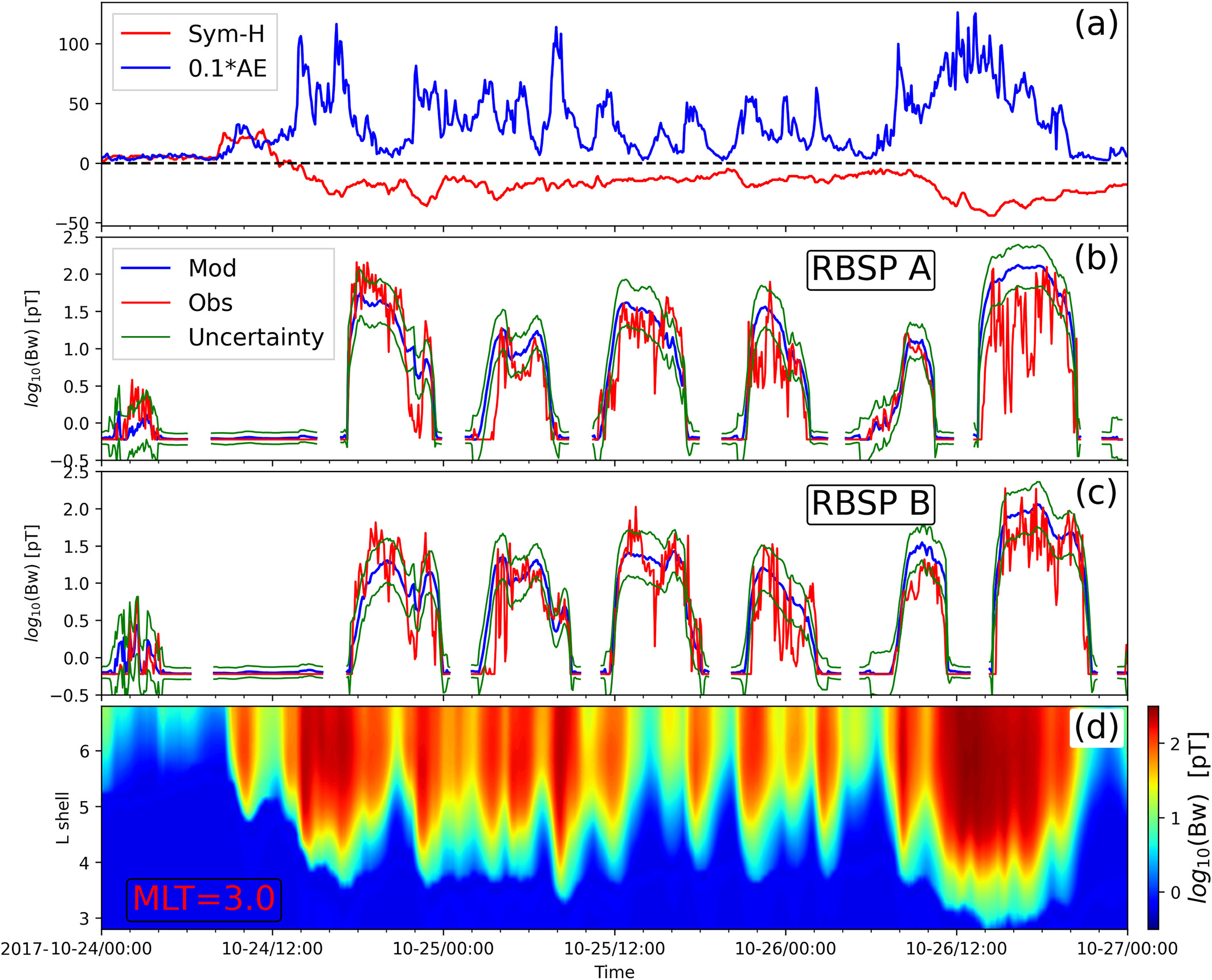 Distribution and Evolution of Chorus Waves Modeled by a Neural Network: The Importance of Imbalanced RegressionXiangning Chu, Jacob Bortnik, Wen Li, and 5 more authorsSpace Weather, 2023
Distribution and Evolution of Chorus Waves Modeled by a Neural Network: The Importance of Imbalanced RegressionXiangning Chu, Jacob Bortnik, Wen Li, and 5 more authorsSpace Weather, 2023Whistler-mode chorus waves play an essential role in the acceleration and loss of energetic electrons in the Earth’s inner magnetosphere, with the more intense waves producing the most dramatic effects. However, it is challenging to predict the amplitude of strong chorus waves due to the imbalanced nature of the data set, that is, there are many more non-chorus data points than strong chorus waves. Thus, traditional models usually underestimate chorus wave amplitudes significantly during active times. Using an imbalanced regressive (IR) method, we develop a neural network model of lower-band (LB) chorus waves using 7-year observations from the EMFISIS instrument onboard Van Allen Probes. The feature selection process suggests that the auroral electrojet index alone captures most of the variations of chorus waves. The large amplitude of strong chorus waves can be predicted for the first time. Furthermore, our model shows that the equatorial LB chorus’s spatiotemporal evolution is similar to the drift path of substorm-injected electrons. We also show that the chorus waves have a peak amplitude at the equator in the source MLT near midnight, but toward noon, there is a local minimum in amplitude at the equator with two off-equator amplitude peaks in both hemispheres, likely caused by the bifurcated drift paths of substorm injections on the dayside. The IR-based chorus model will improve radiation belt prediction by providing chorus wave distributions, especially storm-time strong chorus. Since data imbalance is ubiquitous and inherent in space physics and other physical systems, imbalanced regressive methods deserve more attention in space physics.
-
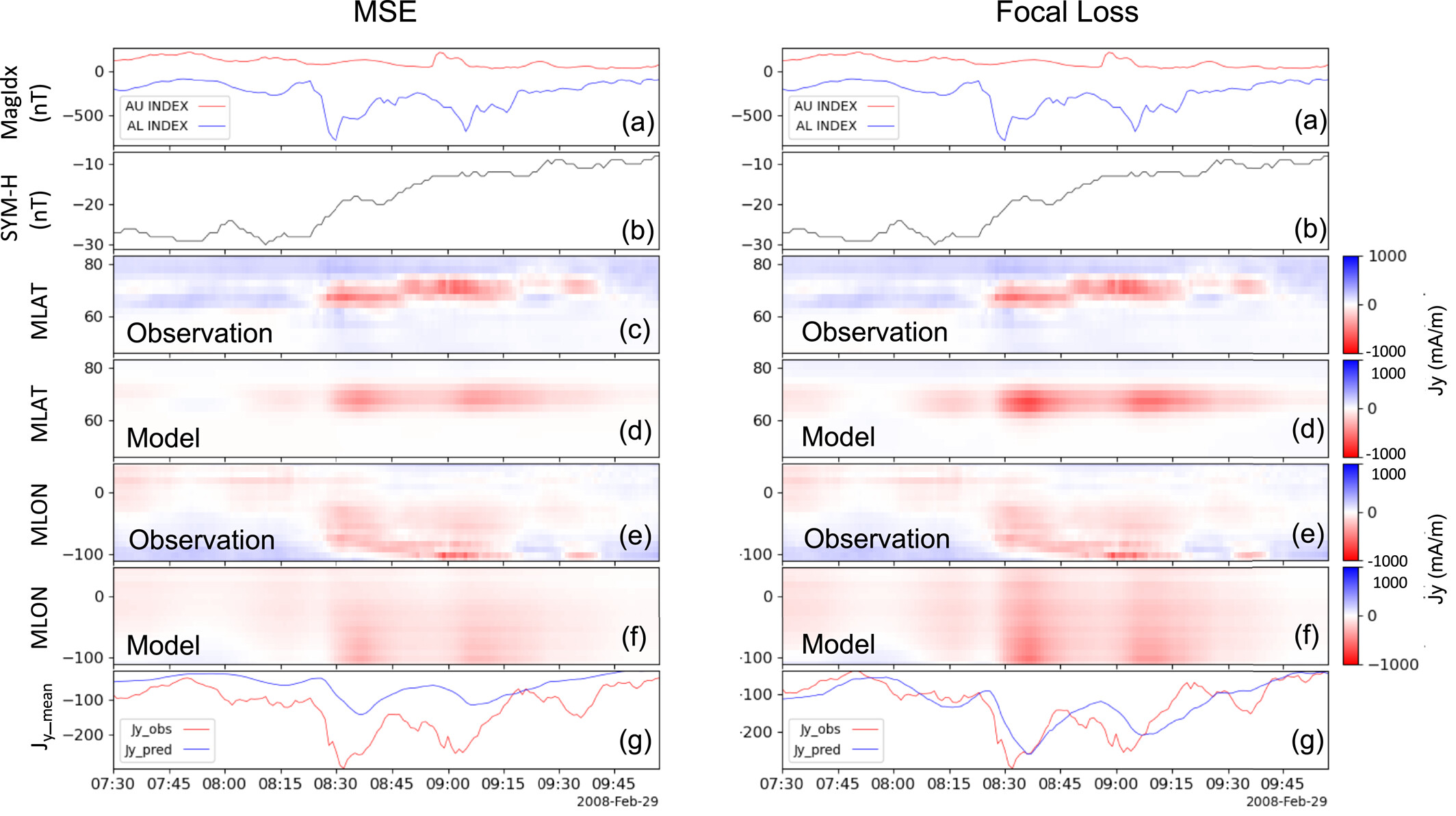 The Response of Ionospheric Currents to External Drivers Investigated Using a Neural Network-Based ModelXin Cao, Xiangning Chu, Jacob Bortnik, and 4 more authorsSpace Weather, 2023
The Response of Ionospheric Currents to External Drivers Investigated Using a Neural Network-Based ModelXin Cao, Xiangning Chu, Jacob Bortnik, and 4 more authorsSpace Weather, 2023A predictive model for the variation of ionospheric currents is of great scientific and practical importance to our modern industrial society. To study the response of ionospheric currents to external drivers including geomagnetic indices and solar radiation, we developed a feedforward neural network model trained on the Equivalent Ionospheric Current (EIC) data from 1st January 2007 to 31st December 2019. Due to the highly imbalanced nature of the ionospheric currents data, which means that the data of extreme events are much less than those of quiet times, we utilized different loss functions to improve the model performance. Our model demonstrates the potential to predict the active events of ionospheric currents reasonably well (e.g., EICs during substorms) within a timescale of a few minutes. Although the data used for training are measurements over the North American and Greenland sectors, our model is not only able to predict EICs within this region, but is also able to provide a promising out-of-sample prediction on a global scale.
-
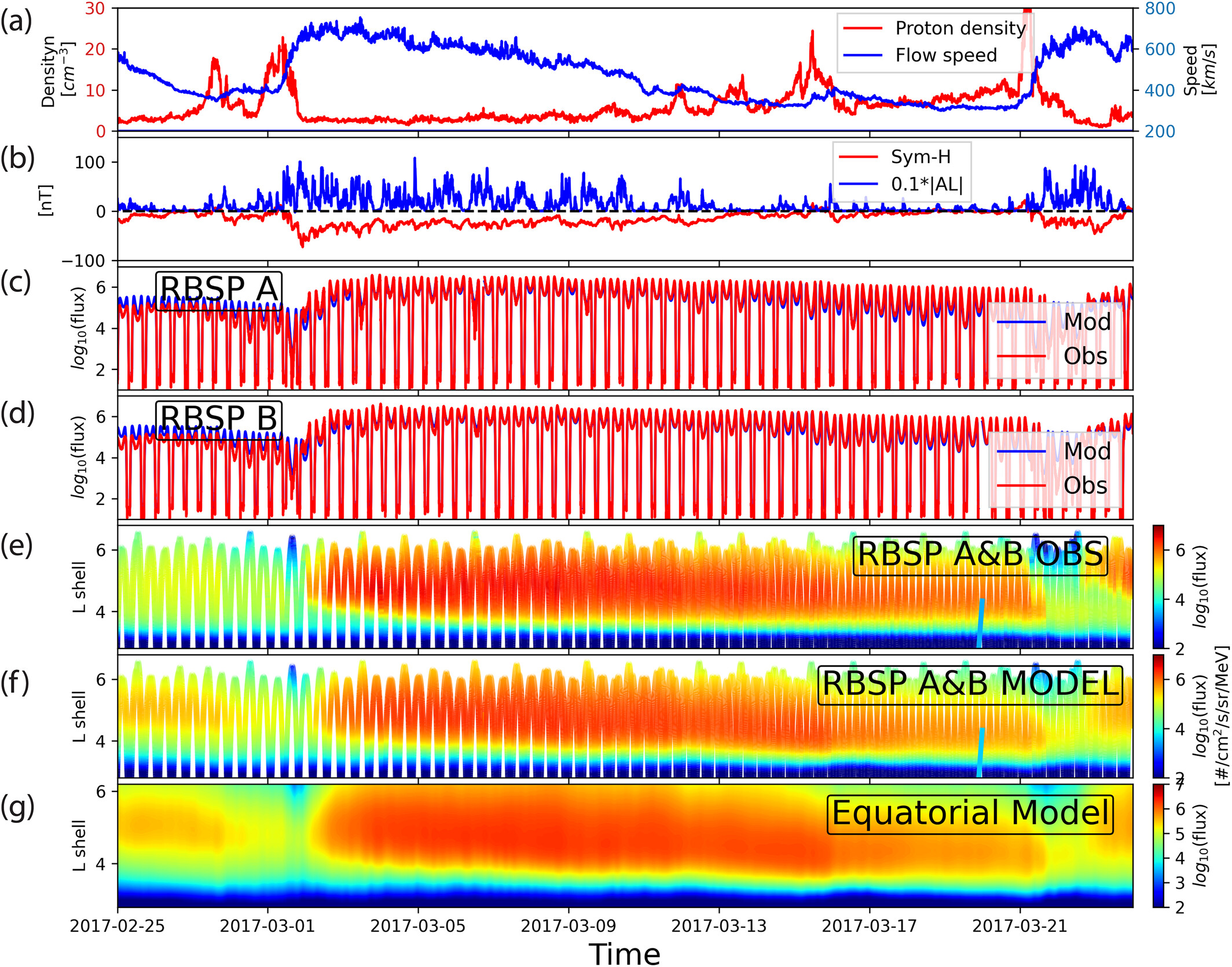 Relativistic Electron Model in the Outer Radiation Belt Using a Neural Network ApproachXiangning Chu, Donglai Ma, Jacob Bortnik, and 10 more authorsSpace Weather, 2021
Relativistic Electron Model in the Outer Radiation Belt Using a Neural Network ApproachXiangning Chu, Donglai Ma, Jacob Bortnik, and 10 more authorsSpace Weather, 2021We present a machine-learning-based model of relativistic electron fluxes \textgreater1.8 MeV using a neural network approach in the Earth’s outer radiation belt. The Outer RadIation belt Electron Neural net model for Relativistic electrons (ORIENT-R) uses only solar wind conditions and geomagnetic indices as input. For the first time, we show that the state of the outer radiation belt can be determined using only solar wind conditions and geomagnetic indices, without any initial and boundary conditions. The most important features for determining outer radiation belt dynamics are found to be AL, solar wind flow speed and density, and SYM-H indices. ORIENT-R reproduces out-of-sample relativistic electron fluxes with a correlation coefficient of 0.95 and an uncertainty factor of ∼2. ORIENT-R reproduces radiation belt dynamics during an out-of-sample geomagnetic storm with good agreement to the observations. In addition, ORIENT-R was run for a completely out-of-sample period between March 2018 and October 2019 when the AL index ended and was replaced with the predicted AL index (lasp.colorado.edu/home/personnel/xinlin.li). It reproduces electron fluxes with a correlation coefficient of 0.92 and an out-of-sample uncertainty factor of ∼3. Furthermore, ORIENT-R captured the trend in the electron fluxes from low-earth-orbit (LEO) SAMPEX, which is a completely out-of-sample data set both temporally and spatially. In sum, the ORIENT-R model can reproduce transport, acceleration, decay, and dropouts of the outer radiation belt anywhere from short timescales (i.e., geomagnetic storms) and very long timescales (i.e., solar cycle) variations.
-
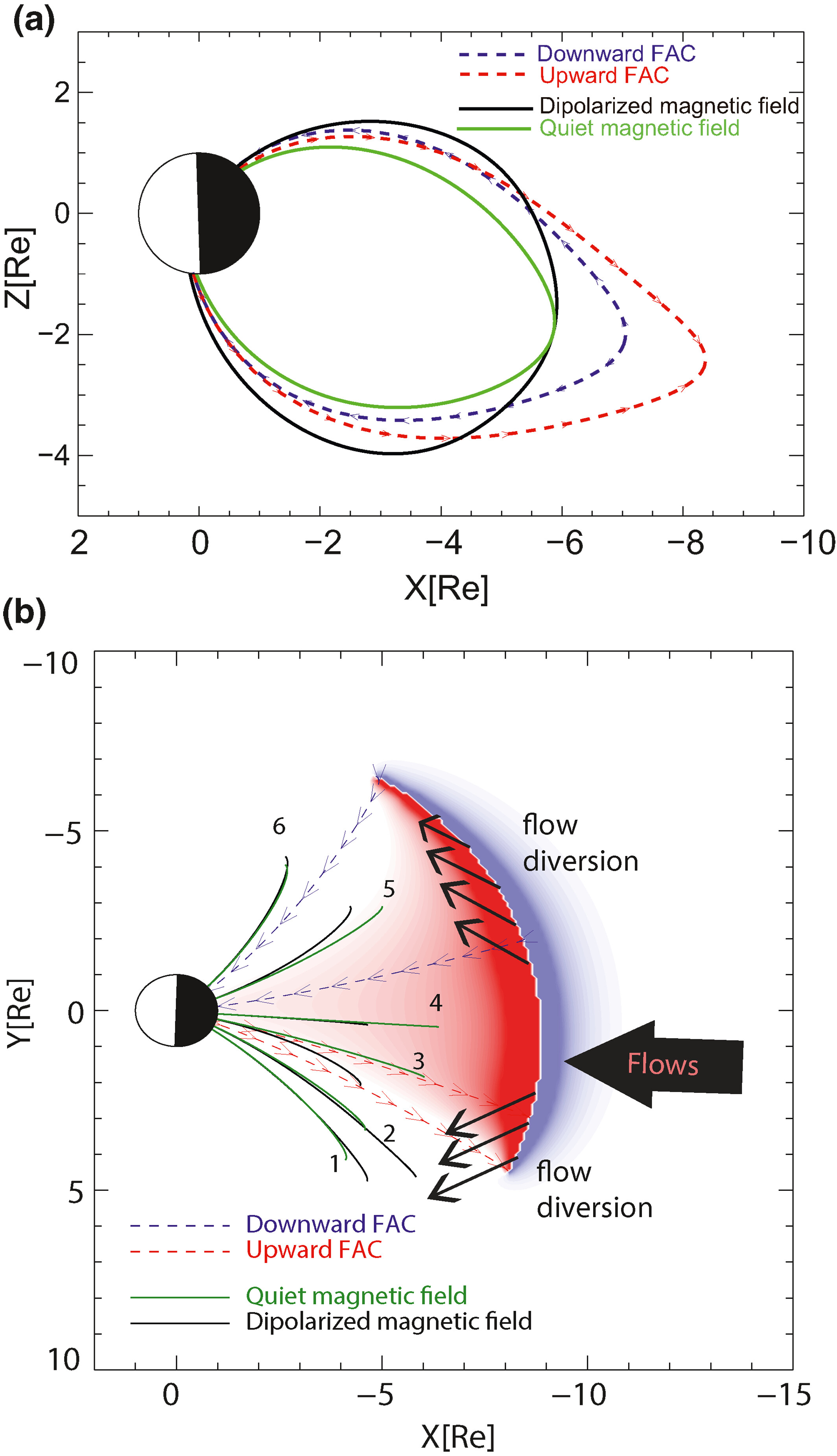 Magnetotail Flux Accumulation Leads to Substorm Current Wedge Formation: A Case StudyXiangning Chu, Robert McPherron, Tung-Shin Hsu, and 4 more authorsJournal of Geophysical Research: Space Physics, 2021
Magnetotail Flux Accumulation Leads to Substorm Current Wedge Formation: A Case StudyXiangning Chu, Robert McPherron, Tung-Shin Hsu, and 4 more authorsJournal of Geophysical Research: Space Physics, 2021Reconnection-generated earthward flows, magnetic field dipolarizations, and auroral expansions are related to substorm current wedge (SCW) development. It has been suggested that field-aligned currents (FACs) within the SCW can be generated by flow vortices, pressure gradients, or both. Observations related to these generation mechanisms differ from one event to another, due to their different locations relative to SCW’s central meridian and timing relative to the SCW’s evolutionary state. A pattern of in situ observations consistent with these generation mechanisms has yet to emerge. Obtaining such a pattern of in situ observations relies on the satellite locations relative to the FAC driver regions, which are hard to determine because coincident magnetotail observations are sparse. To solve this problem, an SCW inversion technique was used to model the FAC locations and determine the connections between magnetospheric and ionospheric phenomena. Using this technique, the magnetic flux, a parameter that is relatively insensitive to FAC locations, was analyzed during an isolated substorm on February 13, 2008. We compared the temporal variations of the accumulated flux that caused magnetic dipolarization in the SCW and the flux within the auroral poleward boundary. We found them to be in good agreement with the flux transported by earthward flows. This agreement suggests that the accumulation of the magnetic flux leads to the generation of the SCW, causing magnetic dipolarization and auroral poleward expansion. The amount of accumulated flux was found to be positively correlated with the amplitudes of these substorm-related phenomena.
-
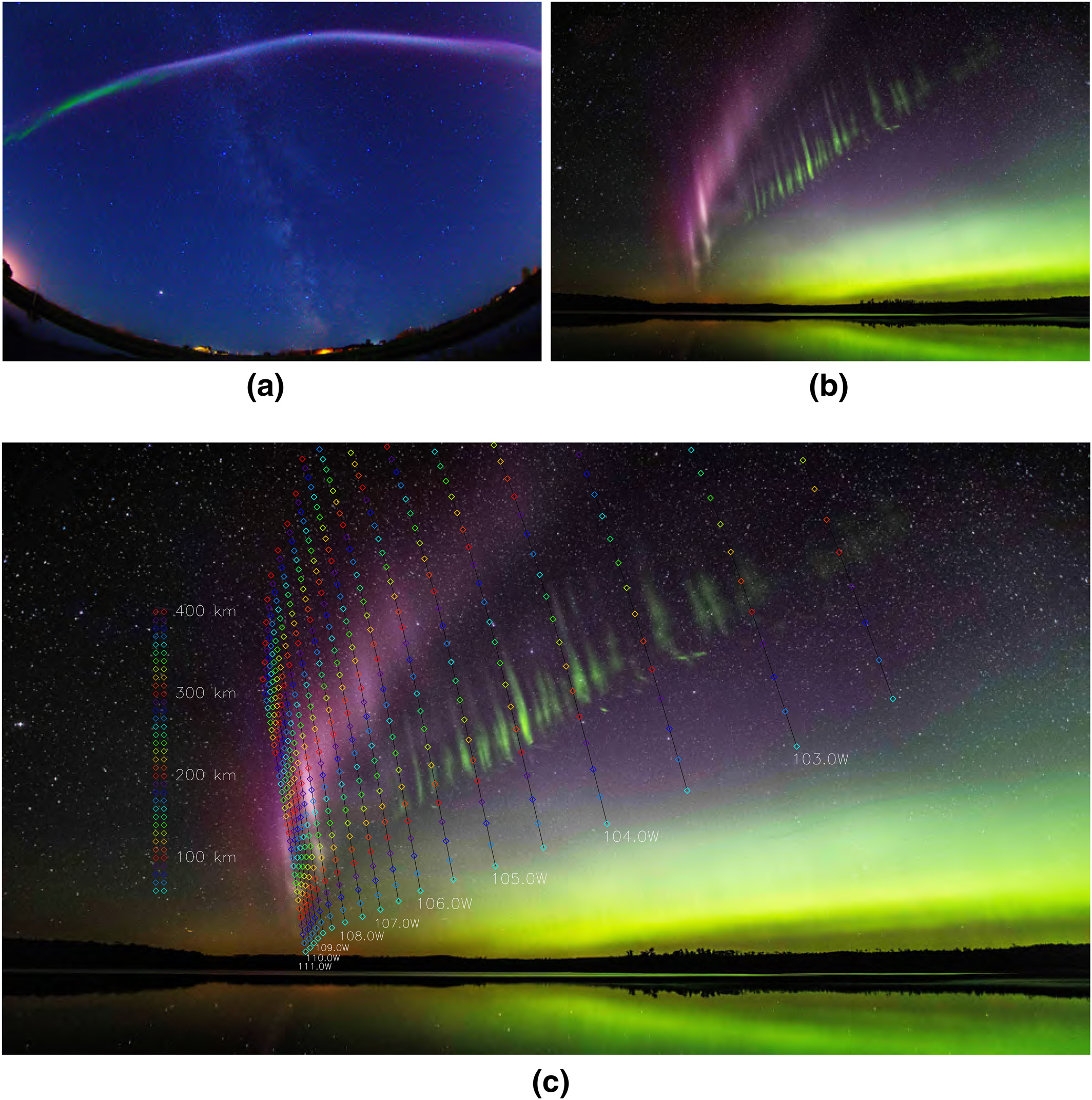 Morphological Characteristics of Strong Thermal Emission Velocity Enhancement EmissionsXiangning Chu, Lukas Wolter, David Malaspina, and 4 more authorsJournal of Geophysical Research: Space Physics, 2020
Morphological Characteristics of Strong Thermal Emission Velocity Enhancement EmissionsXiangning Chu, Lukas Wolter, David Malaspina, and 4 more authorsJournal of Geophysical Research: Space Physics, 2020Morphological characteristics of Strong Thermal Emission Velocity Enhancement (STEVE) are investigated during an event on July 17, 2018. We calibrate photographs from citizen scientists for scientific purposes. We determine the altitude profiles for STEVE emissions. The spectral continuum purplish STEVE emission peaks at 200 km, which is in the altitude range where redline-only SAR emission could be generated. The green picket fence peaks at 110 km, similar to that of the typical green aurora. For both emissions, their altitudes of the peak emissions and the shapes of the altitude profiles are similar across different longitudes. In regions of two-layer purplish STEVE emissions, the lower layer STEVE peaks at ∼130 km with slightly different peak altitudes at different longitudes. The green picket fence structures are separated by 14 km in longitude with a full width of half maximum of ∼5.3 km. They move westward at a roughly constant speed of ∼250 m/s, although they sometimes disappear and reappear. The purplish STEVE and green picket fence emissions are latitudinally narrow, and whether they are simultaneously collocated on the same magnetic field line depends on their latitudinal offset relative to their width. We demonstrate that the green picket fence and purplish STEVE emissions are located on magnetic field lines within a tenth (0.02°) of the latitudinal width of STEVE (0.2°). The fact suggests that different STEVE emissions are driven by the same narrow region either in the ionosphere or the magnetosphere, although their generation mechanisms differ. The morphological characteristics have important implications in determining how STEVE is generated.
-
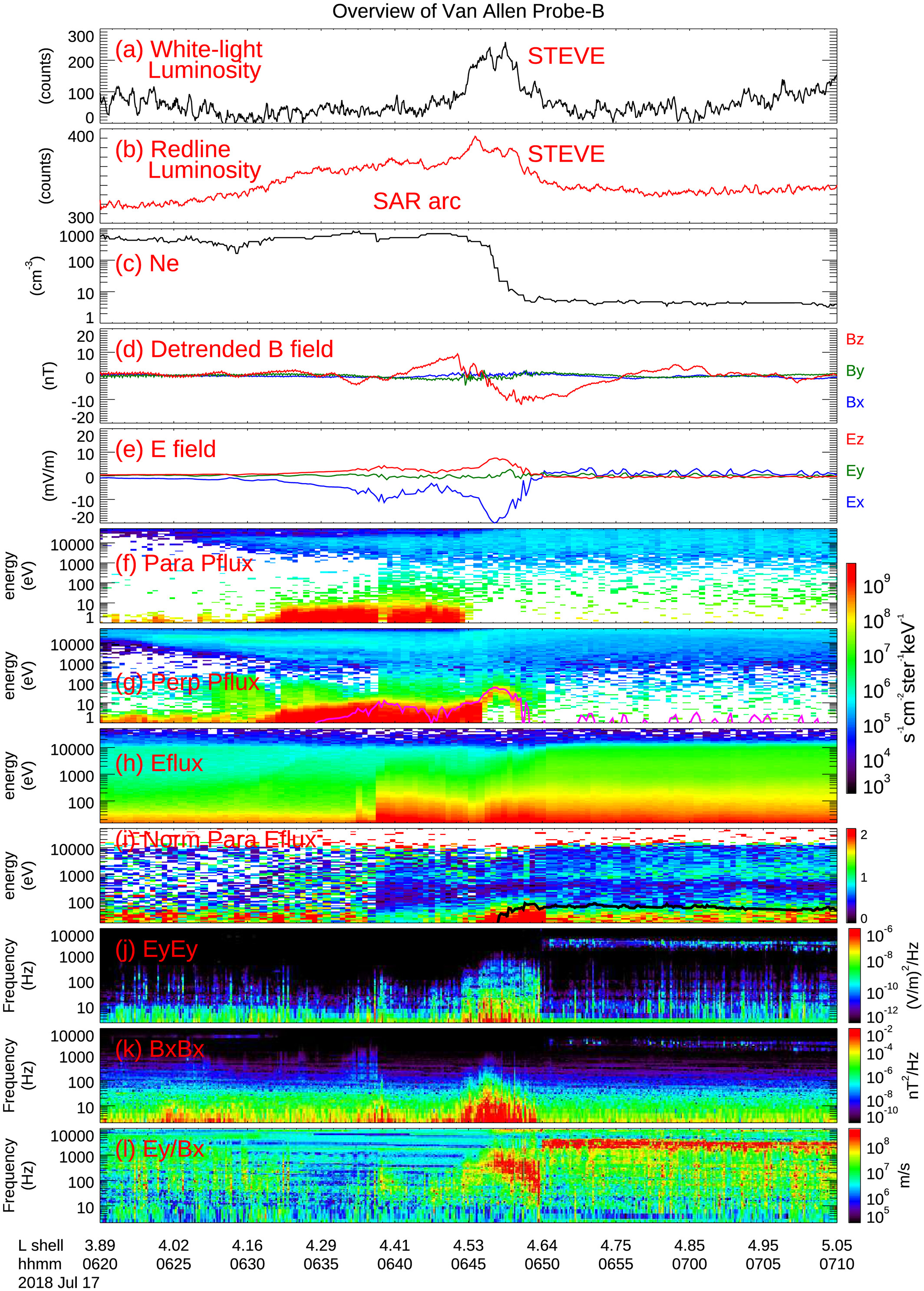 Identifying STEVE’s Magnetospheric Driver Using Conjugate Observations in the Magnetosphere and on the GroundXiangning Chu, David Malaspina, Bea Gallardo-Lacourt, and 18 more authorsGeophysical Research Letters, 2019
Identifying STEVE’s Magnetospheric Driver Using Conjugate Observations in the Magnetosphere and on the GroundXiangning Chu, David Malaspina, Bea Gallardo-Lacourt, and 18 more authorsGeophysical Research Letters, 2019The magnetospheric driver of strong thermal emission velocity enhancement (STEVE) is investigated using conjugate observations when Van Allen Probes’ footprint directly crossed both STEVE and stable red aurora (SAR) arc. In the ionosphere, STEVE is associated with subauroral ion drift features, including electron temperature peak, density gradient, and westward ion flow. The SAR arc at lower latitudes corresponds to regions inside the plasmapause with isotropic plasma heating, which causes redline-only SAR emission via heat conduction. STEVE corresponds to the sharp plasmapause boundary containing quasi-static subauroral ion drift electric field and parallel-accelerated electrons by kinetic Alfvén waves. These parallel electrons could precipitate and be accelerated via auroral acceleration processes powered by Alfvén waves propagating along the magnetic field with the plasmapause as a waveguide. The electron precipitation, superimposed on the heat conduction, could explain multiwavelength continuous STEVE emission. The green picket-fence emissions are likely optical manifestations of electron precipitation associated with wave structures traveling along the plasmapause.
-
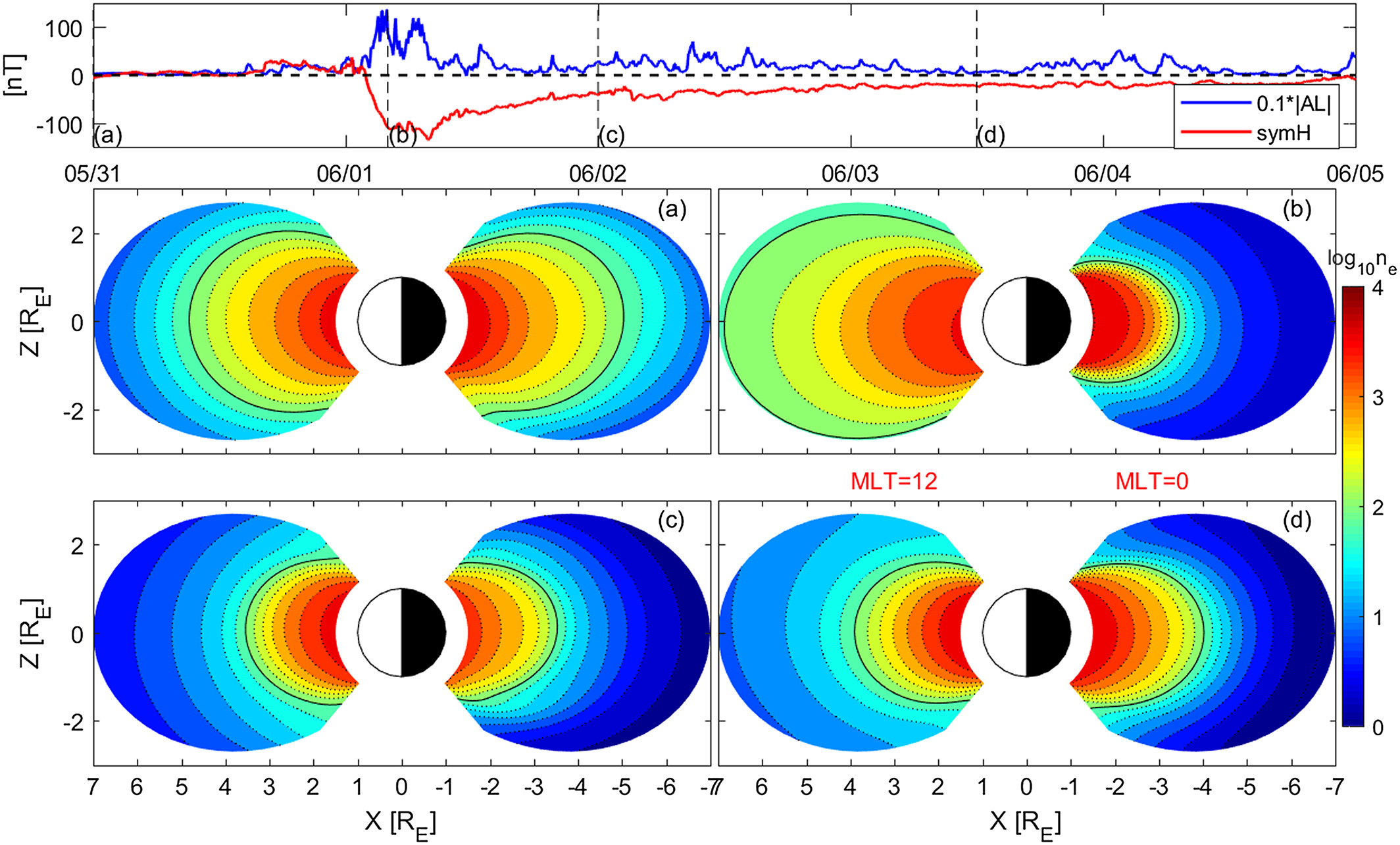 A neural network model of three-dimensional dynamic electron density in the inner magnetosphereX. Chu, J. Bortnik, W. Li, and 10 more authorsJournal of Geophysical Research: Space Physics, 2017
A neural network model of three-dimensional dynamic electron density in the inner magnetosphereX. Chu, J. Bortnik, W. Li, and 10 more authorsJournal of Geophysical Research: Space Physics, 2017A plasma density model of the inner magnetosphere is important for a variety of applications including the study of wave-particle interactions, and wave excitation and propagation. Previous empirical models have been developed under many limiting assumptions and do not resolve short-term variations, which are especially important during storms. We present a three-dimensional dynamic electron density (DEN3D) model developed using a feedforward neural network with electron densities obtained from four satellite missions. The DEN3D model takes spacecraft location and time series of solar and geomagnetic indices (F10.7, SYM-H, and AL) as inputs. It can reproduce the observed density with a correlation coefficient of 0.95 and predict test data set with error less than a factor of 2. Its predictive ability on out-of-sample data is tested on field-aligned density profiles from the IMAGE satellite. DEN3D’s predictive ability provides unprecedented opportunities to gain insight into the 3-D behavior of the inner magnetospheric plasma density at any time and location. As an example, we apply DEN3D to a storm that occurred on 1 June 2013. It successfully reproduces various well-known dynamic features in three dimensions, such as plasmaspheric erosion and recovery, as well as plume formation. Storm time long-term density variations are consistent with expectations; short-term variations appear to be modulated by substorm activity or enhanced convection, an effect that requires further study together with multispacecraft in situ or imaging measurements. Investigating plasmaspheric refilling with the model, we find that it is not monotonic in time and is more complex than expected from previous studies, deserving further attention.
-
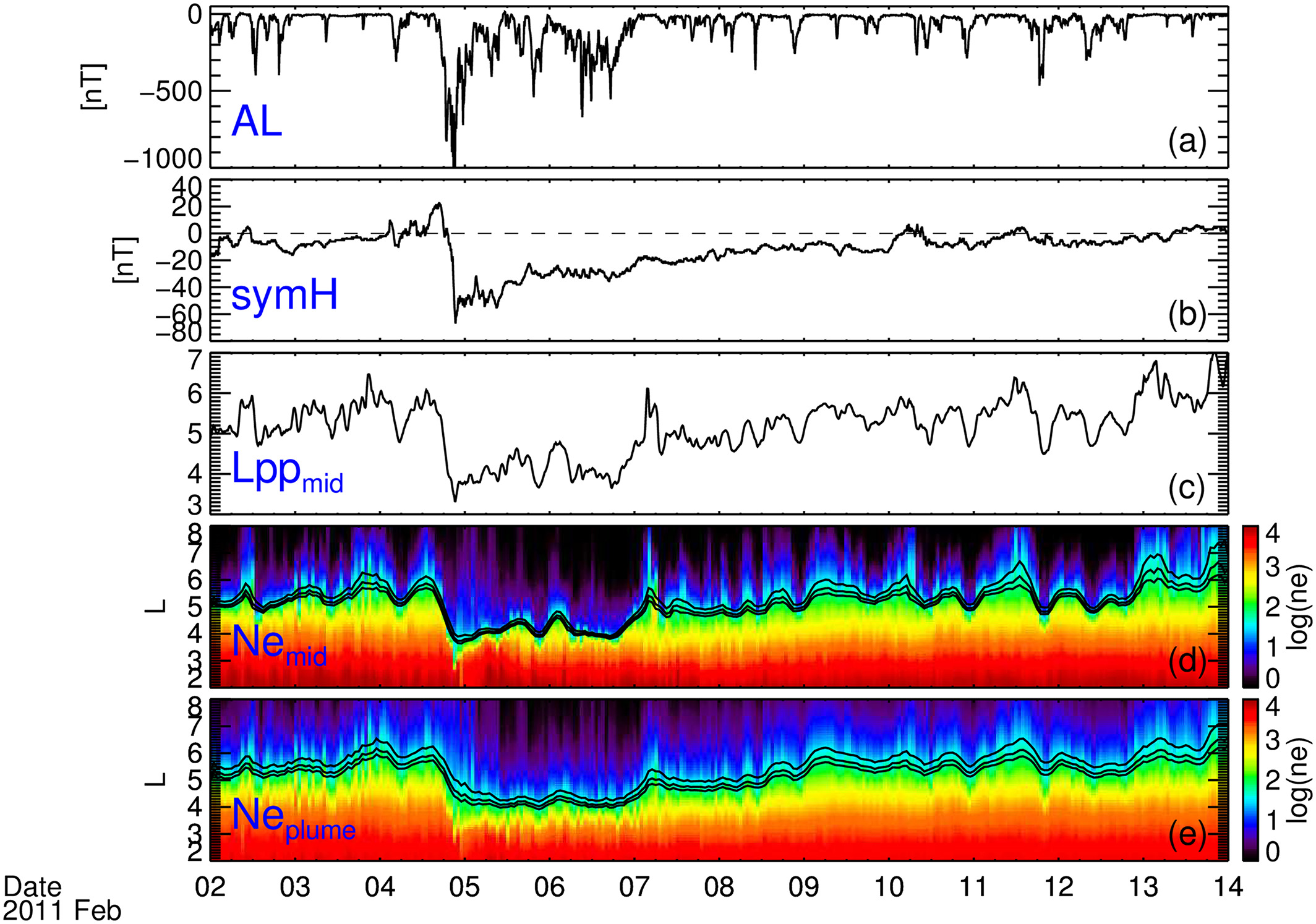 Erosion and refilling of the plasmasphere during a geomagnetic storm modeled by a neural networkX. N. Chu, J. Bortnik, W. Li, and 3 more authorsJournal of Geophysical Research: Space Physics, 2017
Erosion and refilling of the plasmasphere during a geomagnetic storm modeled by a neural networkX. N. Chu, J. Bortnik, W. Li, and 3 more authorsJournal of Geophysical Research: Space Physics, 2017We present a history-dependent model of the equatorial plasma density of the inner magnetosphere using a feedforward neural network with two hidden layers. As the model inputs, we take locations and time series of SYM-H, AL, and F10.7 indices. By considering not only the instantaneous values but also the past values of geomagnetic and solar indices, the model is history dependent on levels of geomagnetic and solar activity. The modeled electron density is continuous both spatially and temporally so that the evolution of the density can be studied (such as plasmaspheric refilling). The model is trained using the electron density inferred from the spacecraft potential from three THEMIS probes. The equatorial electron density is shown to be accurately reconstructed with a correlation coefficient of r 0.953 between data and model target. Since the model is history dependent, it succeeds in reconstructing various density features and dynamic behaviors, such as the quiet time plasmasphere, erosion and recovery of the plasmasphere, as well as the plume formation during a storm on 4 February 2011. Our model may provide unprecedented insight into the behavior of the equatorial density at any time and location; as an example we show the inferred refilling rate from our model and compare it to previous estimates.